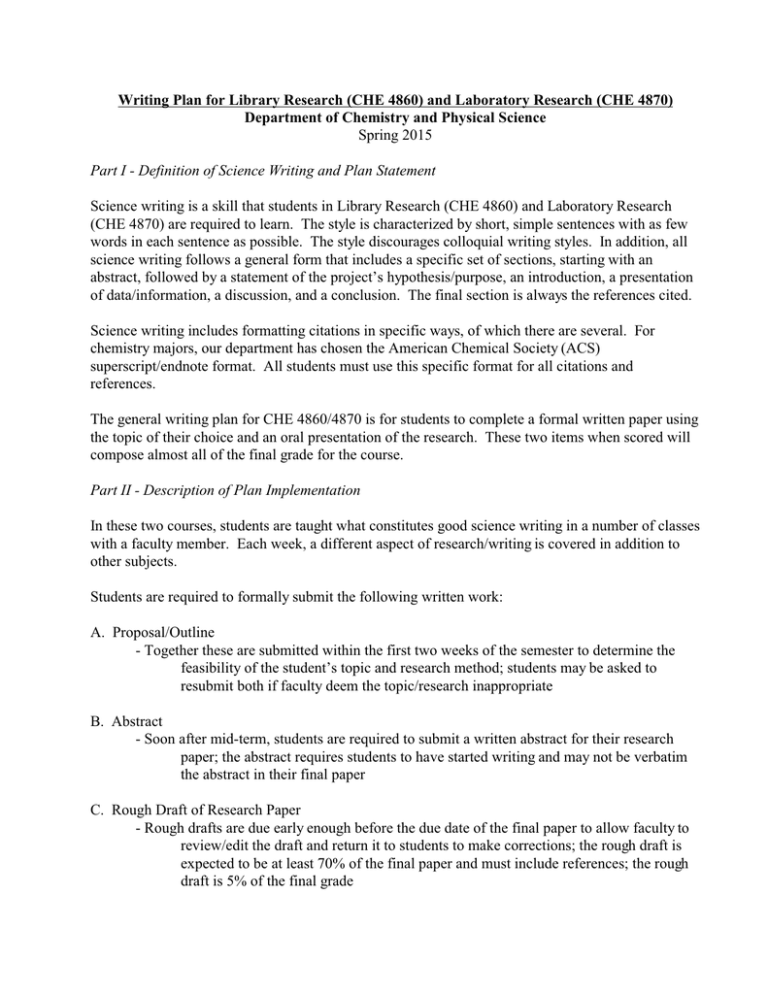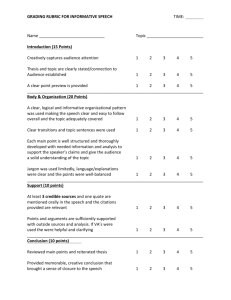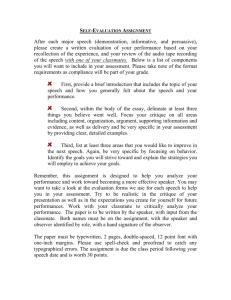Writing Plan for Library Research (CHE 4860) and Laboratory Research... Department of Chemistry and Physical Science
advertisement

Writing Plan for Library Research (CHE 4860) and Laboratory Research (CHE 4870) Department of Chemistry and Physical Science Spring 2015 Part I - Definition of Science Writing and Plan Statement Science writing is a skill that students in Library Research (CHE 4860) and Laboratory Research (CHE 4870) are required to learn. The style is characterized by short, simple sentences with as few words in each sentence as possible. The style discourages colloquial writing styles. In addition, all science writing follows a general form that includes a specific set of sections, starting with an abstract, followed by a statement of the project’s hypothesis/purpose, an introduction, a presentation of data/information, a discussion, and a conclusion. The final section is always the references cited. Science writing includes formatting citations in specific ways, of which there are several. For chemistry majors, our department has chosen the American Chemical Society (ACS) superscript/endnote format. All students must use this specific format for all citations and references. The general writing plan for CHE 4860/4870 is for students to complete a formal written paper using the topic of their choice and an oral presentation of the research. These two items when scored will compose almost all of the final grade for the course. Part II - Description of Plan Implementation In these two courses, students are taught what constitutes good science writing in a number of classes with a faculty member. Each week, a different aspect of research/writing is covered in addition to other subjects. Students are required to formally submit the following written work: A. Proposal/Outline - Together these are submitted within the first two weeks of the semester to determine the feasibility of the student’s topic and research method; students may be asked to resubmit both if faculty deem the topic/research inappropriate B. Abstract - Soon after mid-term, students are required to submit a written abstract for their research paper; the abstract requires students to have started writing and may not be verbatim the abstract in their final paper C. Rough Draft of Research Paper - Rough drafts are due early enough before the due date of the final paper to allow faculty to review/edit the draft and return it to students to make corrections; the rough draft is expected to be at least 70% of the final paper and must include references; the rough draft is 5% of the final grade D. Final Copy of Research Paper - Final copies must have proper grammar, spelling, punctuation, formatting, citations, and references; the final paper must be a minimum of 15 pages long (not including figures) and is 70% of the final grade (the oral presentation is 25% of the final grade) Dr. Dembosky teaches both CHE 4860 and 4870 and provides written feed back for all of the required course submissions. Department faculty may also contribute some feedback. Part III - Course Rubric A rubric for CHE 4860/4870 has been developed that covers all the required aspects of the rough draft, final written paper, and oral presentation. Students are able to view the rubric from the first day of class and it is posted on Blackboard. The second and third pages of the rubric contain descriptions of all the elements on the rubric and how each is graded. A copy of the rubric follows this page. Author _________________________Title ___________________________________________________________ Class CHE 48 Date _________ Evaluator _______ Seminar Evaluation Research Paper Presentation 5 Graded Element Rough Draft 4 Abstract 3 Purpose/Hypothesis 7 Introduction / Background 14 Comments Points Received Possible Points Graded Element Background / Introduction 2.5 7.5 Main Body Content / Method Discussion or Critique / Analysis 6 Summary / Conclusions Core Content Critique / Analysis / Conclusions 2.5 3 Comments Purpose / Hypothesis 2.5 Content Points Possible Content Points Received Organization 2.5 Execution and Style Paper Format and Structure 4 Documentation / Citations 4 References / Bibliography Writing Style 3 Sentence Structure and Paragraphs 3 3 Mechanics 3 3 1.5 1.5 Voice 2.5 Digital Slides Graphics 3 Chalkboard Use Transparencies A/V Spelling 0.5 Citations Grammar 0.5 Time Limit Punctuation 1 Attire 7 Figures - Handouts - (Late Deduction) - (Late Deduction) 75 Research Paper Total 25 Presentation Total Other Comments: Seminar Total: Research Paper Evaluation Rubric Brief Explanation All reviewers using this rubric should address the following questions when scoring the submitted paper. It should be noted that some categories on the rubric may not be applicable for all papers. Rough Draft Is the rough draft the required length? Are there sections that could be moved to a better location in the final paper? Are the methods, data, and discussion properly separated? Does the paper follow a logical order? Does the content fit the required format for the paper? Do citations and references follow the proper format? Abstract Is the abstract a good complete summary of the paper? Is the abstract as short as possible? Are references avoided in the abstract? Purpose/Hypothesis - Introduction/Background Was there a part of the paper to introduce the audience to the topic? Were the technical terms used in the writing defined at the beginning of the paper? Did the author clearly identify the purpose of the paper and/or provide an overview of the structure of the paper (if needed/required)? / What is the proposal for the research conducted and on what is it based? Main Body Content / Method Is the paper adequately fact-checked? Is the content of the paper appropriate and adequate? Is there enough content to cover the topic of the paper? / Did the research method logically fit the research proposal? Were an adequate number of tests and methods performed? Were positive and negative results observed? Are appropriate charts and graphs included of the procedures if needed? Discussion or Critique / Analysis Did the writer critique any published sources? Were alternate views presented? Did the author include his or her own views, and if so, were they adequately supported? / How well were the results presented? Is all of the appropriate data included? Are data organized in appropriate charts and graphs if needed? Are amounts of error properly conveyed? Summary / Conclusions Is there a summary or set of conclusions in the paper? Are the conclusions clearly presented? Are the conclusions that of the author or of those of a source or several sources? What are some options for further research on the paper’s topic? Paper Format and Structure Is there an orderly arrangement of ideas and information presented in the paper from start to finish? Are concepts addressed in the appropriate place within the text? Is any concept or idea mentioned without a proper context? Documentation / Citations Were any parts of the paper not cited that should have been? Was the required format of the citations strictly followed? Were parts of the paper documented too much in a specific paragraph when a paraphrasing citation would suffice? References / Bibliography Did the writer use the format for the references that was required? Are the references in alphabetical order? Is each reference complete? Are the references from appropriate sources (i.e., peer-reviewed journals)? Writing Style Is the writing professional or is the document written colloquial (i.e., is the writing style more like a published paper or an informal verbal conversation)? Were unnecessary words and verbiage left in the writing that could have been omitted? Did the writer try to say as much as possible with as few words as possible? Sentence Structure and Paragraphs Were the rules of sentence structure followed (use of proper subjects and predicates)? Did the writer use runon sentences and/or sentence fragments too often? Were sentences comprehensible? Did each paragraph have a main/topic sentence? Were paragraphs written to focus on the topic sentence? Did the writer begin a new paragraph when needed? Spelling Has an effort been made to make sure all spelling is correct beyond using a spell-checker? Did the author distinguish homophones (such as to/two/too and they’re/their/there)? Is “a lot” spelled as two separate words? Grammar Did the writer avoid beginning sentences with conjunctions? Is the tense of the writing consistent? Did the author avoid the “dirty dozen” of the English Department? Punctuation Were parenthetical phrases separated by commas? Were conjunctions preceded by commas? Were any abbreviations, especially ones that repeat, properly defined? Figures Did all figures have references? Was each figure referred to somewhere in the text? Did each figure have an appropriate caption? ©JAD 2015 Presentation Evaluation Rubric Brief Explanation All reviewers using this rubric should address the following questions when scoring the presentation speaker. It should be noted that some categories on the rubric may not be applicable for all presentations. Purpose/Hypothesis - Background/Introduction Was there a part of the presentation to introduce the audience to the topic? Were the technical terms used in the presentation defined at the beginning of the presentation? Did the speaker provide a “hook” to attract the attention of the audience? Did the speaker clearly identify the purpose of the presentation and/or provide an overview of the structure of the presentation? Core Content Was the topic of the presentation adequately explained? Did the presenter convey adequate research of the topic? If personal research was conducted, did it follow the scientific method? Has data been presented entirely? Critique/Analysis/Conclusions Fact based presentation (Critique and Conclusions): Were opposing views expressed in the presentation? Did the speaker include a critique of the research presented? Were the speaker’s own views expressed? Did the speaker present a summary of important concepts expressed throughout the presentation? Research based presentation (Analysis and Conclusions): Did the speaker present alternative or additional research methods that could be used to further support or refute the presented results? Did the speaker compare any results with other studies? Did the speaker clearly summarize the results of personal research? Organization Was there a clear structure to the presentation? Did the speaker have difficulty staying “on topic” and/or often change the subject abruptly? Execution and Style Did the speaker maintain a professional composure throughout the presentation? Did the speaker use correct grammar during the presentation? Did the speaker directly address the audience or the graphics (or floor, wall, window, etc.)? Voice Did the speaker speak too quickly or too slowly? Was everyone in the audience able to hear the speaker? Graphics Digital Slides: Were the computer slides well organized? Did slides have too much or too little text? Were graphics used or not used when needed? Was a clear font utilized? Was the color palette of the slides distracting or unclear? Was the background of the slides appropriate? Where the slides in the proper order? Chalkboard: Was the presenter’s penmanship legible? Did the presenter write crooked on the board? Was the chalkboard used appropriately? Transparencies: Were the transparencies legible? Did the transparencies adequately enhance the presentation? Was writing or drawing on the transparencies clear? A/V: Were video clips used appropriately? Were demonstrations clear and concise? Was it clear that the presenter practiced using miscellaneous props before the presentation? Citations Did the speaker clearly cite references when needed? Was verbal or presented credit given for appropriate information? Time Limit Did the speaker use time wisely during the presentation? Did the speaker stop the presentation short or go over time? Attire Did the speaker dress appropriately for the presentation? Handouts Were the handouts necessary? Were handouts an appropriate outline of the presentation if this was their intention? Did the handouts enhance the presentation? Were the handouts neat, clear, and concise? Other Comments Additional scoring points may rate how the speaker answered questions after the presentation. ©JAD 2015




